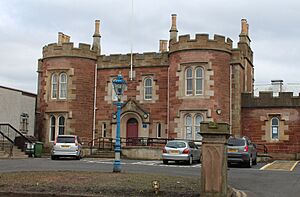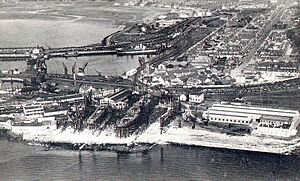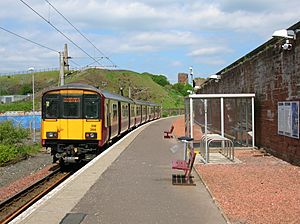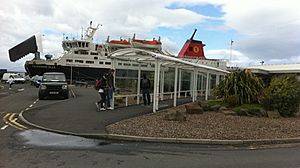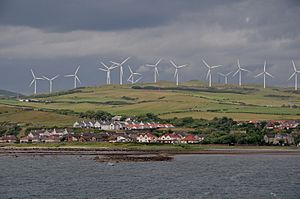Ardrossan facts for kids
Quick facts for kids Ardrossan
|
|
|---|---|
| Town and sea port | |
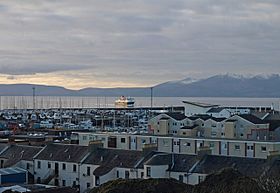 Ardrossan skyline and overlooking Ardrossan Harbour, January 2008 |
|
| Population | 10,500 (2020) |
| OS grid reference | NS232424 |
| • Edinburgh | 79.1 miles (127.3 km) |
| • London | 432.3 miles (695.7 km) |
| Council area | |
| Lieutenancy area |
|
| Country | Scotland |
| Sovereign state | United Kingdom |
| Post town | ARDROSSAN |
| Postcode district | KA22 |
| Dialling code | 01294 |
| Police | Strathclyde |
| Fire | Strathclyde |
| Ambulance | Scottish |
| EU Parliament | Scotland |
| UK Parliament |
|
| Scottish Parliament |
|
Ardrossan (pronounced ar-DROSS-an) is a town on the coast of North Ayrshire in southwest Scotland. Its name comes from Scottish Gaelic and means 'headland of the small promontory'. About 10,670 people live here. Ardrossan is part of a bigger area called the 'Three Towns', which also includes Saltcoats and Stevenston. It sits on the eastern shore of the Firth of Clyde, a large sea inlet.
Ardrossan is important because it's where Caledonian MacBrayne ferries leave for the Isle of Arran.
Contents
History of Ardrossan
Ardrossan's story began around 1140 with the building of its castle. It was built on a spot called 'Cannon Hill' by Simon de Morville. The castle and land later belonged to the Barclay family. In the 14th century, it passed to the Eglinton family.
There's a legend about Sir Fergus Barclay, who was the Baron of Ardrossan. People said he worked with the Devil. In one story, he asked the Devil to make ropes from sand. When the Devil failed, he kicked the castle in frustration. This left a hoofprint in the stone!
The castle stood until 1648. Oliver Cromwell's soldiers destroyed it then. They used much of its stone to build a fort in Ayr. The ruins of this old fort, sometimes called Cromwell's Fort, can still be seen today.
In 1759, the 10th Earl of Eglinton started a special herd of Chillingham cattle in Ardrossan. These were an ancient breed of white, hornless cattle. By 1820, the herd was gone.
Growth as a Port Town
Ardrossan grew a lot in the 18th and 19th centuries. This was because of its great location on the coast. The town's port became busy with ships exporting coal and pig iron to Europe and North America. It also became a centre for shipbuilding.
Shipyards in Ardrossan built fishing boats and small cargo ships. This continued until the 1950s when foreign competition caused the main shipyard to close. A smaller yard, McCrindle's, operated until the 1980s.
Ferry services from Ardrossan Harbour began in 1834, going to Brodick on the Isle of Arran. Later, services started to Belfast in Ireland (1863) and the Isle of Man (1892). The Earl of Eglinton had a big plan for a canal to Glasgow, but it was never built.
Between 1841 and 1848, Ardrossan was part of the fastest way to travel from London to Glasgow. People would take a train to Fleetwood, then a boat to Ardrossan. After 1848, the whole trip could be done by train.
The harbour has been updated and is now a marina. The main ferry to Brodick is still run by Caledonian MacBrayne.
Ardrossan became a burgh (a type of town with its own local government) in 1846. It had a provost and magistrates. After World War II, the burgh was based at Ardrossan Civic Centre. In 1974, it lost its burgh status. Today, Ardrossan is part of North Ayrshire.
In 1921, Ardrossan was the first place in Europe to successfully receive medium wave radio signals from North America. An amateur radio group in Connecticut sent Morse code signals to a station set up in a tent here.
Getting Around Ardrossan
Railway Stations
Ardrossan has three railway stations:
- Ardrossan South Beach: This station is near the border with Saltcoats.
- Ardrossan Town: This station closed in 1968 but reopened in 1987.
- Ardrossan Harbour: This station is close to the port for the Arran ferry.
Ardrossan South Beach station is where the lines to Ardrossan Harbour and Largs split off from the Ayrshire Coast Line. Trains run from Ardrossan South Beach to Glasgow Central twice an hour. One train comes from Ardrossan Harbour (stopping at Ardrossan Town), and the other comes from Largs. All train services from Ardrossan are run by ScotRail.
There are also two old, closed railway stations:
- Ardrossan North: You can still see parts of the platform near Montgomerie Street.
- Ardrossan Montgomerie Pier: This station was further along the line. However, new buildings near the harbour have removed all signs of it.
The last trains ran through these closed stations around 1968. Before that, they mainly served summer boat trips after regular passenger services stopped in 1932.
Roads and Buses
Ardrossan is connected to Glasgow by the A737 road and to Ayr by the A78 road. A new bypass, the A78 Three Towns Bypass, opened in 2004. This has made travel easier and reduced traffic in the Three Towns. Bus services in Ardrossan are mainly run by Stagecoach West Scotland.
Ferry Services
A regular ferry service from Ardrossan to Brodick on the Isle of Arran has been running since 1834. The ferry leaves every two hours and 45 minutes from Monday to Saturday and the trip takes 55 minutes. A ferry service to Campbeltown also started in 2013.
Recently, there have been worries about the future of ferry services from Ardrossan. This is because a part of the harbour, the Irish Berth, was permanently closed. This berth was sometimes used by Caledonian MacBrayne ferries.
In the past, Ardrossan had ferry services to Belfast and, in summer, to the Isle of Man. The Belfast service stopped in 1976. The Isle of Man service stopped in 1985.
Schools in Ardrossan
Ardrossan has three primary schools: St Peter's Primary School, Stanley Primary School, and Winton Primary School.
There are two secondary schools for older students:
- Ardrossan Academy: This school opened in 1882 and has about 1,050 students. Students come from Ardrossan, Saltcoats, West Kilbride, and Seamill.
- St Matthews Academy: This school is in Saltcoats and is for Roman Catholic students from Ardrossan.
Energy and Environment
Ardrossan is located near two nuclear power stations: Hunterston A and Hunterston B.
The town also has the Ardrossan Wind Farm, which opened in 2004. This wind farm has large turbines that create electricity from the wind.
Places of Worship
Ardrossan has five churches:
- St.Peter-in-Chains: This is a Roman Catholic church. It was designed by Jack Coia and opened in 1938. It is a very important historical building.
- Park Church: This is a Church of Scotland church.
- EU Congregational Church
- Church of the Nazarene.
Things to Do and See
- Eglinton Country Park: You can reach this park from Ardrossan using the Sustrans Cyclepath, which is great for cycling.
- The town has a Unionist Club on Princes Street, which started in 1901. There is also a Labour Social Club in Saltcoats.
- Ardrossan has two special offices called consulates, for Denmark and Norway. These help people from those countries.
- The town's cemetery, on Sorbie Road, opened in 1854. It holds the graves of 23 sailors who died when the ship HMS Dasher sank.
Local Government
Ardrossan is part of the Ayrshire North and Arran area for the UK Parliament. It is also part of the Cunninghame North area for the Scottish Parliament.
Historically, Ardrossan was part of different areas for the UK Parliament. These areas used to elect Conservative or Unionist politicians. But since 1987, the area has mostly elected politicians from the Labour Party or the Scottish National Party.
Sports in Ardrossan
Ardrossan is home to several sports teams. These include:
- Ardrossan Winton Rovers: This is a association football (soccer) club that plays in the West of Scotland League.
- North Ayrshire Table Tennis Club.
Castlehill: A Historic Spot
Castlehill is also known as 'Cannon Hill' by local people. It's a historic place where people were buried long ago. In the 1950s, one tomb was moved to the Barony Church for safety.
In the 1890s, a historian named John Smith dug up an ancient shell-mound on the side of Cannon Hill. This mound was 102 feet long and 16 feet wide. It was mostly under a rock face, which had formed a natural shelter. The digging showed that people had lived in this shelter many times over a long period.
The mound was made of seashells, mostly periwinkles and limpets, and animal bones. Things found there included a stone 'anchor', pieces of old pottery, bone chisels, and bone needles. Today, you can't see any sign of the mound.
Famous People from Ardrossan
- Roy Aitken: A footballer who was captain of Celtic Football Club and the Scotland national team.
- Sam Black: An artist.
- Kenneth Campbell: A Flying Officer who received the Victoria Cross for bravery.
- Dugald Drummond: Born in Ardrossan in 1840, he was a chief engineer for the Caledonian Railway.
- Peter Drummond: A senior executive for the Glasgow and South Western Railway.
- Billy Gilmour (footballer): A professional footballer who played for Rangers F.C and now plays for Brighton & Hove Albion F.C..
- Janet Hendry: The first female pilot in Scotland.
- John Kerr: A physicist who discovered the Kerr effect.
Other Places Named Ardrossan
The name Ardrossan has also been given to places in other parts of the world:
- Ardrossan, South Australia
- Ardrossan, Alberta in Canada
- Ardross, Western Australia
- Ardrossan is also the name of a large estate near Philadelphia in the United States.
See also
 In Spanish: Ardrossan para niños
In Spanish: Ardrossan para niños



